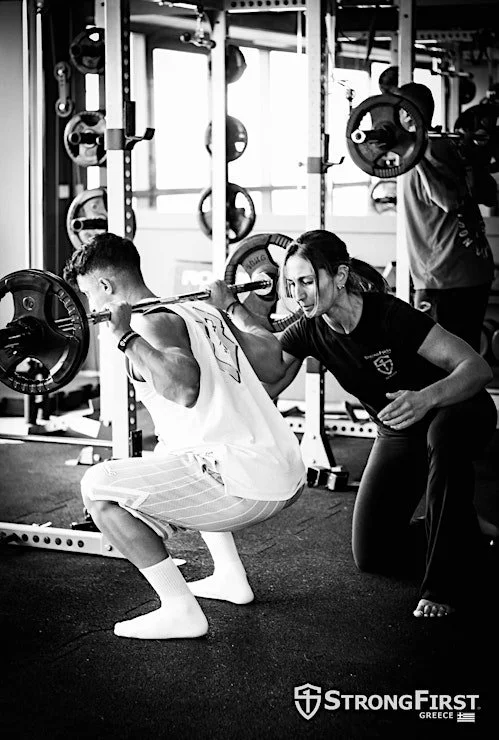Consistency, Made Practical: How Often Is “Enough”?
“Consistency is key” gets thrown around a lot—but what counts as consistent? And how much is enough to see real change?
Here’s our simple, OMP-tested answer:
8 weeks at 2–3 sessions/week → noticeable, motivating change.
6–12 months at 2–3 sessions/week → you keep those gains and build on them.
Years of steady training → strength and capacity that sticks (and survives a two-week family vacation).
Why frequency matters
Biology loves repetition. Your body adapts to what you regularly ask it to do.
1x/week can maintain or reintroduce movement, but 2–3x/week is the sweet spot for visible progress.
When you hit a PR, you don’t stop—you keep training so that performance becomes your new normal.
The Consistency Flywheel
Consistency makes consistency easier. Three parts:
Make a routine. Put your training in the calendar like any appointment.
Stack small wins. Short sessions count. Progress is exposure × time.
Refine your skill. Strength is a skill; like language learning, immersion (more quality reps) beats the occasional cram.
Think “practice strength,” not “chase sweat.”
What Consistency Looks Like at OMP
Minimalist — 2 sessions/week (≈8 sessions/month)
Great for:
Busy parents building the habit without burning out
Folks who move a lot outside the gym (physical jobs, sports) and must manage recovery
Anyone returning from time off who wants momentum without overwhelm
What to expect: Gradual strength, better energy, fewer aches—sustainable.
Steady Progress — 3 sessions/week (≈12 sessions/month)
Great for:
Students who use the gym as their main weekly movement
Hikers who want easier weekend adventures
Recreational athletes building resilience and reducing injury risk
What to expect: Visible changes across 8–12 weeks; stronger lifts, better technique.
Strong Athlete — 3–5 sessions/week (≈12–20+ sessions/month)
Great for:
Flexible schedules and higher performance goals
Seasoned lifters and athletes syncing strength with sport
What to expect: Compounded progress, deeper skill, and durable strength that holds through life’s chaos.
How to Make It Stick (without maxing your willpower)
1) Pre-decide your days. Mon/Wed, Tue/Thu/Sat—whatever fits your life.
2) Keep sessions bite-sized. 40–55 minutes of focused practice beats 90 minutes of random.
3) Track the right things. Sets/reps, RPE (effort), and how you felt—not just the heaviest weight.
4) Use your support (OMP members):
Quarterly Check-In (20 min): adjust your plan every 90 days. Bring your wins, sticking points, and a goal for the next block.
Chat with a Coach Anytime: quick video form checks and on-demand guidance.
Community: show up for your class; your people make it easier. Accountability is a strength tool—use it.
Beginner vs. Experienced: Why patience looks different
Beginners
Gains come fast—but fade quickly if you stop showing up.
Consistency is often fueled by excitement and “new PR” energy.
Experienced Lifters
Gains come slower—but they stick through vacations, travel, and busy seasons.
Consistency is fueled by a sturdy routine and the joy of movement—even when motivation dips.
Bottom line: Either way, showing up is the unlock.
For Our Martial Arts Crew (and anyone learning complex skills)
Don’t be surprised if someone who “just shows up more” starts catching you. Frequency = more reps = more chances to refine timing, pressure, and position. On the flip side, don’t be surprised when your consistency unlocks skills you once swore you’d never master.
Your Next Step (pick one)
Pick a sustainable pace.
Choose the rate of change you want (slow, steady, or faster) and match it to a schedule you can actually keep.
Pro Tip: Be honest with yourself! Slow & steady is always a safer bet when in doubt. Increasing when ready is gratifying, decreasing after struggling feels like losing momentum.Engineer your consistency.
Block training on your calendar, set out clothes the night before, tell family/coworkers you’ll be unavailable, and—when possible—train with a friend for built-in accountability.Pro Tip: Don’t rely on motivation. Build friction-reducers and hurdle-busters you know you’ll need (e.g., earlier bedtime, pre-packed gym bag, a backup “20-minute” plan for busy days).
Track what matters.
Use progress indicators that reflect your goal—e.g., sets/reps, RPE (effort), weekly attendance, pain-free range, hiking pace, or how you feel after sessions. If it moves you toward your goal, measure it.
Pro Tip: This can require some deeper personal questions around different health related goals and corresponding progress indicators. When in doubt as a coach!
Not sure where to start?
Book a free 20-minute consultation and we’ll align your goals, week, and membership so consistency feels doable—and works.
Or email us at info@ompgym.com and we’ll get you set up.














Consistency isn’t magic—it’s frequency, focus, and a plan you can repeat. In this month’s Saturday Steel, we show exactly how often to train to see real change, plus simple ways to make it stick using OMP’s check-ins, coaching, and community. Pick a routine that fits your life and start building strength that lasts.